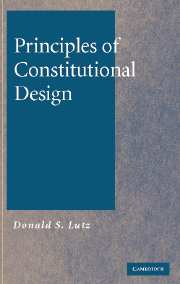Book contents
- Frontmatter
- Contents
- Preface
- Acknowledgments
- Principles of Constitutional Design
- 1 Constitutionalism: An Initial Overview and Introduction
- 2 Sovereignty
- 3 Popular Sovereignty
- 4 The Separation of Powers
- 5 Analyzing the Interaction between Popular Control and the Separation of Powers in the Amendment Process
- 6 Matching a Government to a People
- 7 An Overview of the Constitutional Design Project
- 8 An Underlying Constitutional Logic: Rational Actors?
- Index
1 - Constitutionalism: An Initial Overview and Introduction
Published online by Cambridge University Press: 29 July 2009
- Frontmatter
- Contents
- Preface
- Acknowledgments
- Principles of Constitutional Design
- 1 Constitutionalism: An Initial Overview and Introduction
- 2 Sovereignty
- 3 Popular Sovereignty
- 4 The Separation of Powers
- 5 Analyzing the Interaction between Popular Control and the Separation of Powers in the Amendment Process
- 6 Matching a Government to a People
- 7 An Overview of the Constitutional Design Project
- 8 An Underlying Constitutional Logic: Rational Actors?
- Index
Summary
A Recurrence to Fundamentals
Thomas Jefferson is famous for his notion that every generation should engage in revolution to preserve the blessings of liberty. The notion of “revolution” in use then, contrary to ours today, did not connote a violent break with the past but a thoughtful evolution away from the present. The early American state constitutions spoke of a “frequent recurrence to fundamental principles” as the bulwark of freedom and constitutional government. The framers of the United States Constitution included an amendment process at the end – not as an afterthought, but as the embodiment of this frequent recurrence to fundamentals, this permanent (r)evolution.
“Recurrence” does not mean “the reestablishment of” or “adherence to original intention.” The recent debate over the intentions of the American founders has been far from sterile, but that discussion is not what is meant here. Rather, “recurrence to fundamental principles” involves the action of going back mentally and in discourse to recapture the principles that inform and animate our constitutional system, to reconsider these principles in the light of altered circumstances and commitments, and either to reaffirm in contemporary language and symbols what still speaks the truth to us or to alter and then ratify formally modifications or additions to these principles.
We stand in need of such a recurrence in part, ironically, because our political system seems to have triumphed in the face of a half-century struggle with our political antithesis – the nondemocratic, anticonstitutional Soviet Union.
Information
- Type
- Chapter
- Information
- Principles of Constitutional Design , pp. 1 - 25Publisher: Cambridge University PressPrint publication year: 2006
